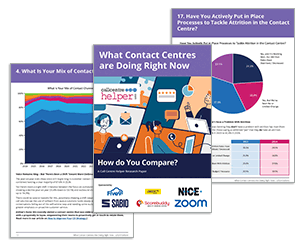Donna Lightfoot at NICE explores how the shift to digital-first customer service has transformed workforce management, creating new challenges and opportunities for contact centres and back-office teams as they navigate complex, multi-channel interactions.
The transition to digital-first customer service has fundamentally changed the nature of workforce management.
Contact centres and back-office environments now manage a variety of digital interactions, including tickets, emails, chats, social media, SMS, and more, in addition to voice calls. This shift has created a new set of challenges and opportunities.
Organizations face increased pressure to scale their customer service operations, but scalability is not just about handling more interactions – it’s also about maintaining high-quality service across all channels.
Modern customer interactions are often more complex than interactions of the past, requiring multiple steps or a coordinated effort across departments to resolve issues that range from technical to operational and more.
A customer submitting an insurance claim, for example, may have issues related to the policy details, technical challenges submitting via the online portal, and questions about a past payment, all of which require the involvement of people outside of customer service.
Along the way, the customer may interact with customer service via phone, chat, text, and email and may respond to requests for more information immediately, or not for a few days.
With such complexity involved, modern workforce management (WFM) tools and best practices are essential to coordinate and optimize the various resources involved.
Why Digital-First Matters When It Comes to WFM
With customer service now asynchronous and interactions taking place on a variety of channels, organizations face a host of new challenges, and core WFM solutions often fall short.
Core WFM systems may not integrate well with other modern digital tools and platforms, leading to fragmented operations and data silos.
When systems are not integrated, agents are often asked to enter or reconcile data manually, increasing errors and reducing efficiency.
Many of these systems lack real-time data processing capabilities, leading to delays in gaining actionable insights, and they don’t always scale in line with the business.
In contrast, digital-first WFM solutions are designed for modern customer service environments and the workflows required today.
Cloud-based, flexible, and scalable, they allow teams to access tools and data from anywhere, enabling remote work and ensuring effective collaboration regardless of where employees are working. With no need for complex hardware installations, implementation and updates are faster.
Digital-first WFM also provides AI-driven real-time insights, predictive analytics, and automated processes to help manage the workforce more effectively.
By leveraging these advanced tools, companies can ensure they have the right number of agents with the right skills available at the right times, boosting service levels and customer satisfaction.
These capabilities extend to the back office teams that support and span multiple business lines and processes; a large proportion of customer satisfaction (and cost) is directly related to work performed in the back office.
Best Practices for Managing Complex Workstreams
Leading organizations are embracing the following WFM best practices to effectively manage their multi-step digital workstreams:
Plan for Long-Term Capacity Needs
Effective capacity planning is critical in managing the modern distributed customer service workforce. By leveraging historical data and predictive analytics, organizations can forecast demand accurately.
Scenario planning tools allow teams to anticipate the impact of factors such as attrition and absence, enabling agile decision-making without reliance on cumbersome spreadsheets.
This allows for better planning and forecasting, ensuring that customer service teams are always prepared to handle incoming workloads.
Gain Visibility With Real-Time Dashboards and Insights
In today’s data-driven landscape, visibility is critical. Digital-first WFM enables the visibility required to effectively manage multi-step digital workstreams.
Comprehensive reporting and real-time dashboards empower managers to track performance, monitor adherence, and identify trends across channels. Insights into metrics like average handle time and first-contact resolution drive informed decision-making, ensuring optimal resource allocation.
This equips managers with a balanced view of service delivery, so they can make informed decisions to optimize the performance of their workforce.
Boost Collaboration and Adaptability
When people across the business can collaborate, they can more easily and effectively prepare for the future. This adaptability helps organizations navigate evolving customer expectations.
Modern WFM solutions enable easy sharing of capacity plans and forecasts with multiple business roles from within the WFM suite.
This fosters collaboration and ensures alignment on workforce strategies. Modern digital-first solutions also offer the ability to create different scenarios, helping the organization adapt to future changes and uncertainties.
Leverage AI for Scalability
Scalability enables organizations to scale up when demand peaks, providing timely and effective support, and scale down during quieter times, controlling costs.
An AI-driven, digital-first WFM solution allows contact centres and back offices to automate routine processes, reducing the administrative burden on agents and managers; leverage real-time data and predictive analytics to quickly and efficiently resolve customer issues across channels; and optimize resources across digital channels with AI-driven forecasts.
Bridge Front and Back Office Operations
The need to scale customer service goes beyond managing front-line interactions, as back-office operations also play a critical role in delivering a seamless customer experience.
Unified digital-first WFM platforms help bridge the gap between the front office and the back office by providing visibility across all functions, automating task assignments, and ensuring consistency across touchpoints.
With digital-first WFM, organizations can manage interactions across tickets, cases, social media, and more from a single platform, and WFM teams can automatically assign tasks to the right people, increasing efficiency and facilitating compliance.
Embracing the Future of Workforce Management
As customer expectations continue to evolve, organizations must adopt forward-thinking strategies and technologies to remain competitive.
Digital-first WFM solutions provide the tools needed to manage complex workflows, scale operations effectively, and exceed customer expectations.
By leveraging the power of AI and cloud-based solutions to do more with less, organizations can deliver great service while minimizing costs.
This blog post has been re-published by kind permission of NICE – View the Original Article
For more information about NICE - visit the NICE Website
Call Centre Helper is not responsible for the content of these guest blog posts. The opinions expressed in this article are those of the author, and do not necessarily reflect those of Call Centre Helper.
Author: NICE
Reviewed by: Rachael Trickey
Published On: 13th Feb 2025 - Last modified: 14th Feb 2025
Read more about - Guest Blogs, NICE, NICE CXone






 NICE is a leading global enterprise software provider that enables organizations to improve customer experience and business results, ensure compliance and fight financial crime. Their mission is to help customers build and strengthen their reputation by uncovering customer insight, predicting human intent and taking the right action to improve their business.
NICE is a leading global enterprise software provider that enables organizations to improve customer experience and business results, ensure compliance and fight financial crime. Their mission is to help customers build and strengthen their reputation by uncovering customer insight, predicting human intent and taking the right action to improve their business. 































